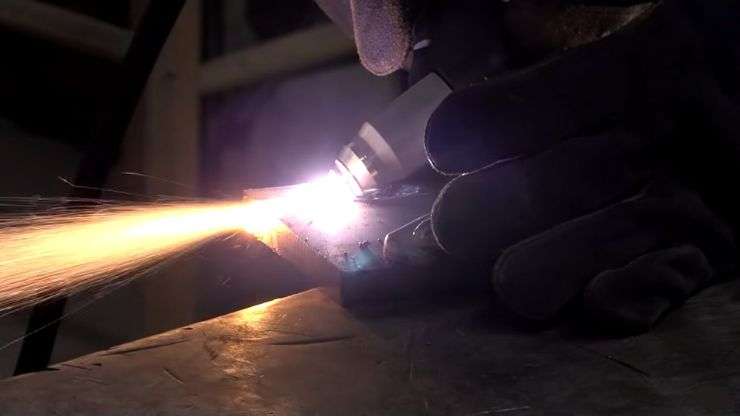What is Plasma Gouging?
In general, gouging is a process that removes material from a workpiece through the use of thermal or mechanical energy. There are four known technologies of metal gouging - oxyfuel, mechanical (grinding, chipping, etc.), carbon electrode, and plasma. Also, there are several gouging techniques like straight, weaved, or side. Here we shall limit our discussion to plasma gouging.
Plasma gouging involves almost a similar process to plasma cutting except that gauging needs to focus the plasma arc (an intensely heated and high-speed stream of ionized gas) or torch at an angle on the electrically conductive workpiece. Because of the torch's angled position and the use of designated gouging consumables, the resultant plasma arc becomes wide and soft. The thrust of the plasma jet stream rapidly melts the workpiece metal, and the molten metal debris gets blown away by the gas stream.
Mechanics of Plasma Gouging
Plasma gouging is a modification of plasma cutting. The plasma gouging process needs to employ a wider dia constricting orifice compared to plasma cutting. The wide dia constricting orifice broadens the focus of the plasma jet stream and drops its velocity. The hole on a gouging tip could be as big as four times that of a cutting one. The cone shape of a gouging tip throws the plasma jet out, aiding in higher removal of material than a cutting tip. Achieving plasma gouging requires the torch to drive at around 30 to 50 degrees angle to the surface of the workpiece metal. The depth of gouging depends on plasma arc velocity, the torch angle, and the torch's travel speed. The volume of material removed and the gouge profile depends on tip size, amperage, travel speed, lead angle, and standoff distance. Plasma gouging is also known as plasma arc gouging.
In removing excessive amounts of material, multiple passes are preferable instead of a single pass while keeping the needed gouging depth and width.
Also Read: What Is Plasma Cutting – How Does It Work?
Difference between Plasma Cutting and Plasma Gouging
Every plasma cutter is not capable of gouging. Gouging-capable plasma cutters are more powerful than those of only plasma cutting. Moreover, the electrodes and nozzles required for plasma gouging are not similar to those of cutting. Plasma gouging produces minimal smoke and noise, and its operating cost is lower than plasma cutting. Plasma gouging doesn't pierce the metal as opposed to plasma cutting.
Advantages of Plasma Gouging
Required Gases for Plasma Gouging
For plasma gouging, there are several gas or gas combination options like argon, nitrogen, helium, oxygen, compressed air, an argon-hydrogen mixture, and oxygen. Here we discuss the gouging performance for each of the gases.
- A combination of argon-35% hydrogen is the most preferred gas for plasma gouging. It provides a clean, consistent, shiny, and smooth gouge on stainless steel and aluminum.
- Argon produces top-quality gouges, but it is relatively slow at removing metal.
- The arc of helium is suitable for creating wide and shallow grooves.
- Compressed air and nitrogen can produce fair-grade gouges on mild steel, stainless steel, and C-Mn alloy steels. Though, the quality may not be as good as that of an argon-hydrogen mix.
- Compressed air is not preferable to gouge on aluminum.
- Plasma gouging with nitrogen will provide extended consumable life.
- Nitrogen and compressed air will keep the operating cost low.
- Compressed air, nitrogen, and argon are proper for cooling.
Applications of Plasma Gouging
Plasma gouging is a widely accepted process for cleaning metal surfaces, creating grooves, removing rivets, making slots, creating apertures, removing temporary brackets, removing welds, etc. Industries like manufacturing, construction, shipbuilding, automotive, maintenance, foundry, and repair have vast applications of plasma gouging. Plasma gouging works with all electrically conductive materials like stainless steel, mild steel, aluminum, alloys of ferrous or nonferrous metals, composite materials, etc.
Conclusions
Though there are a lot of scopes to improve the plasma gouging process, it has already exceeded other gouging processes in terms of efficiency, operating cost, and safety. Plasma gouging is even recommended for new users because it is easy to handle.
Read More
- How to Optimize Plasma Cutter Performance?
- Plasma Cutting Consumables – An Expert Guide
- Plasma Cutter Guide – System Requirements And Cutting Procedure
- Miller Plasma Cutter 375 Reviews – Definitive Guide!
- Hobart Airforce 12CI Plasma Cutter Reviews & Guide
- 10 Best Plasma Cutter Reviews and Buying Guide – 2023
